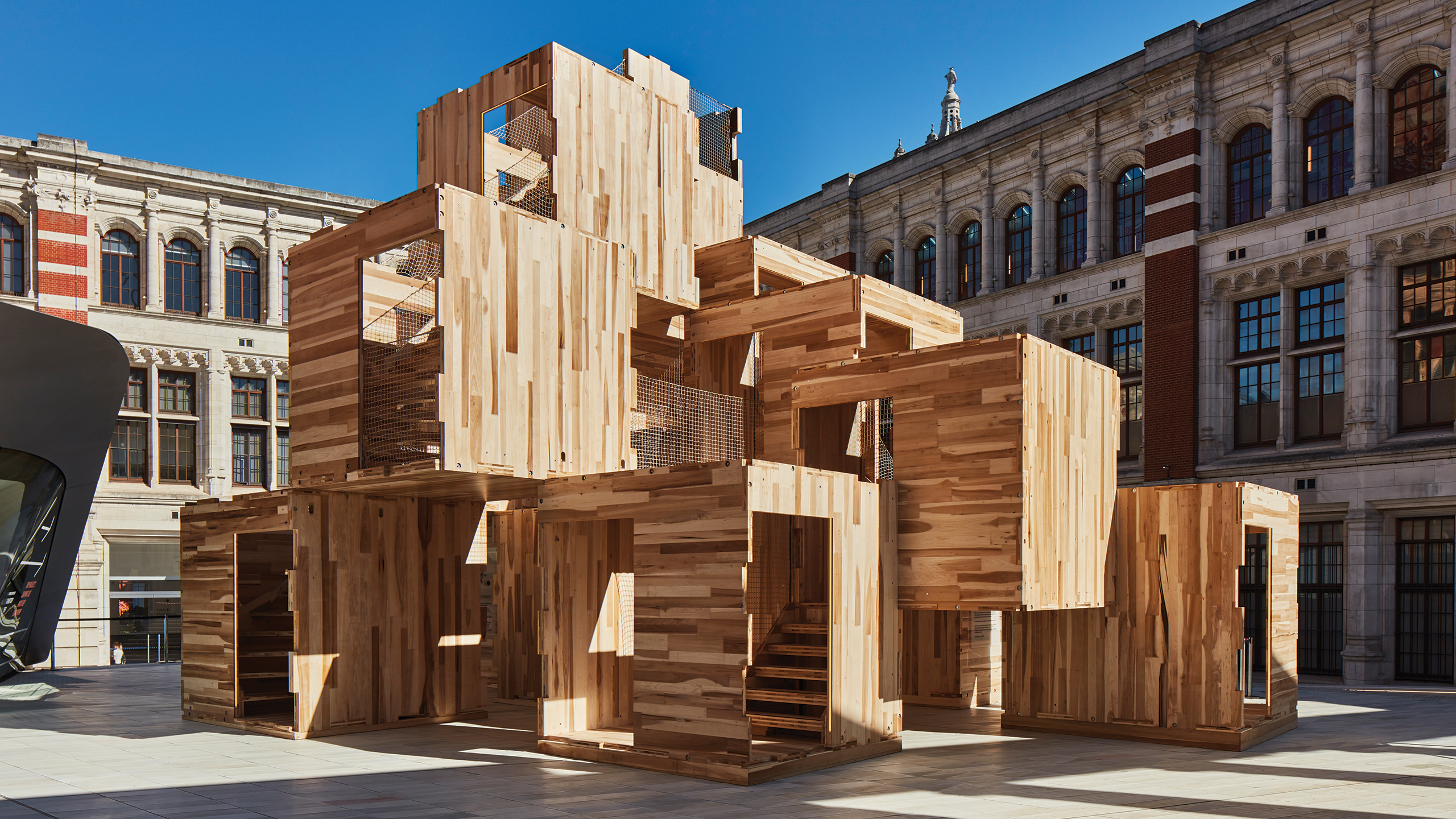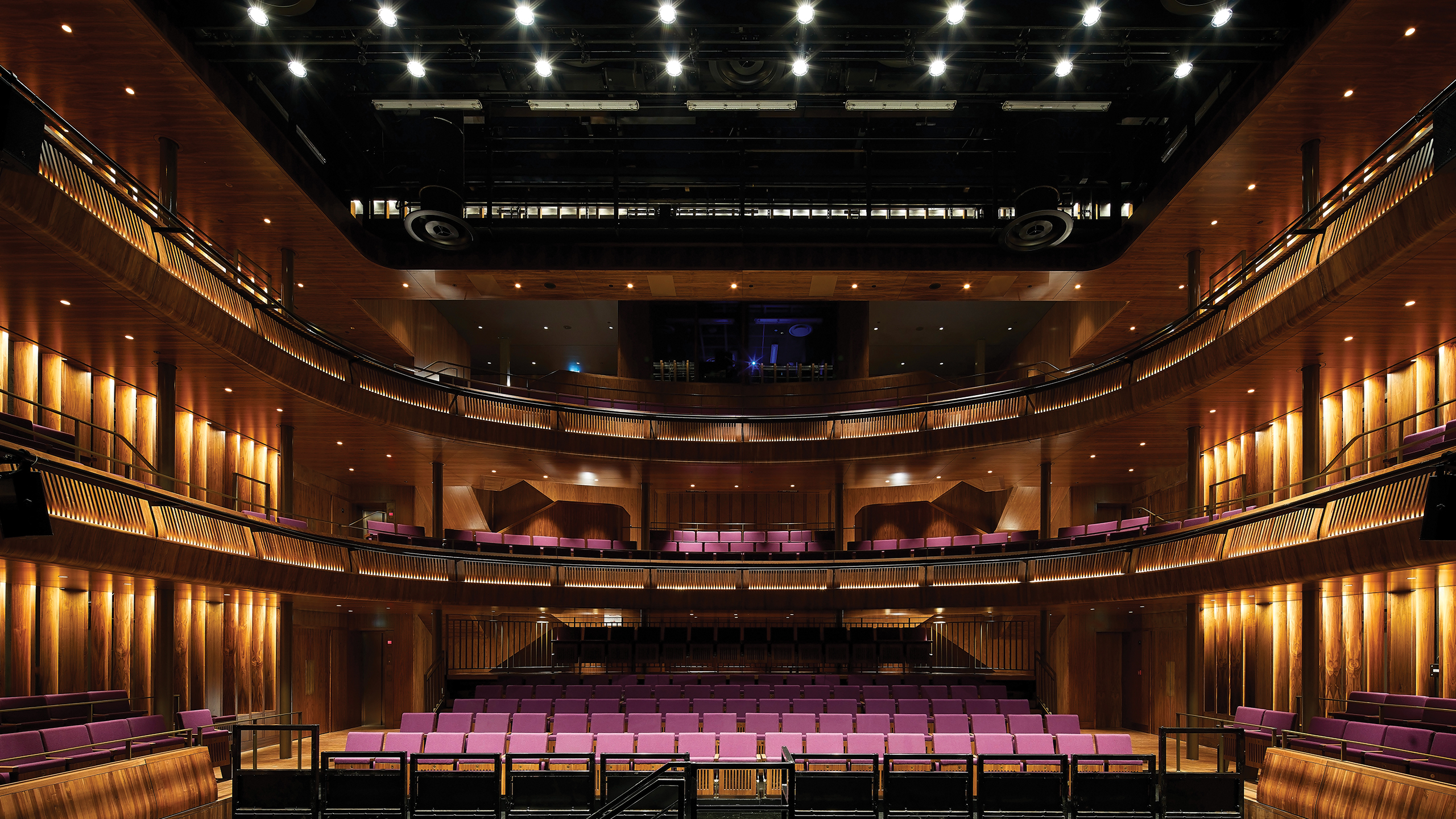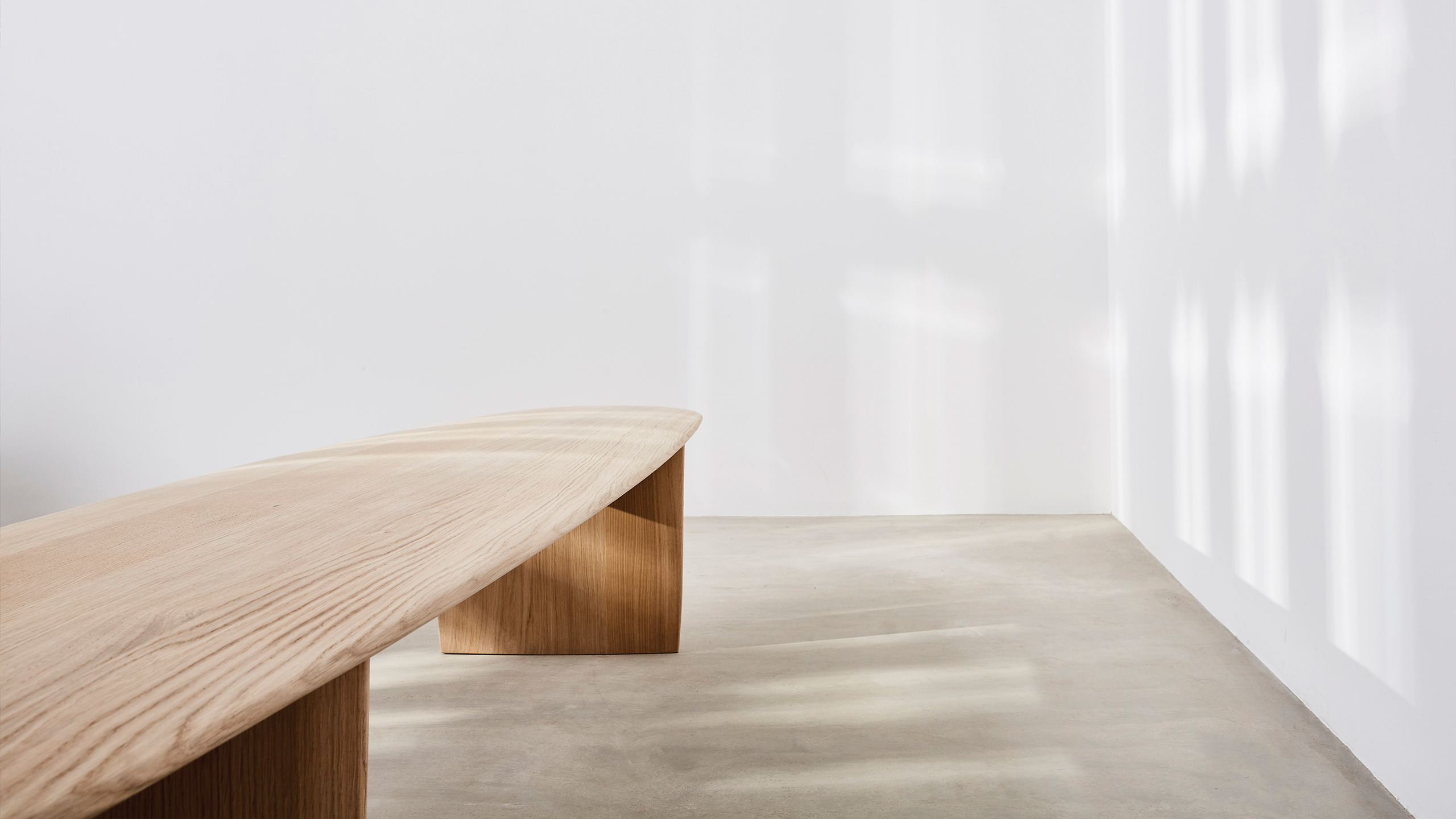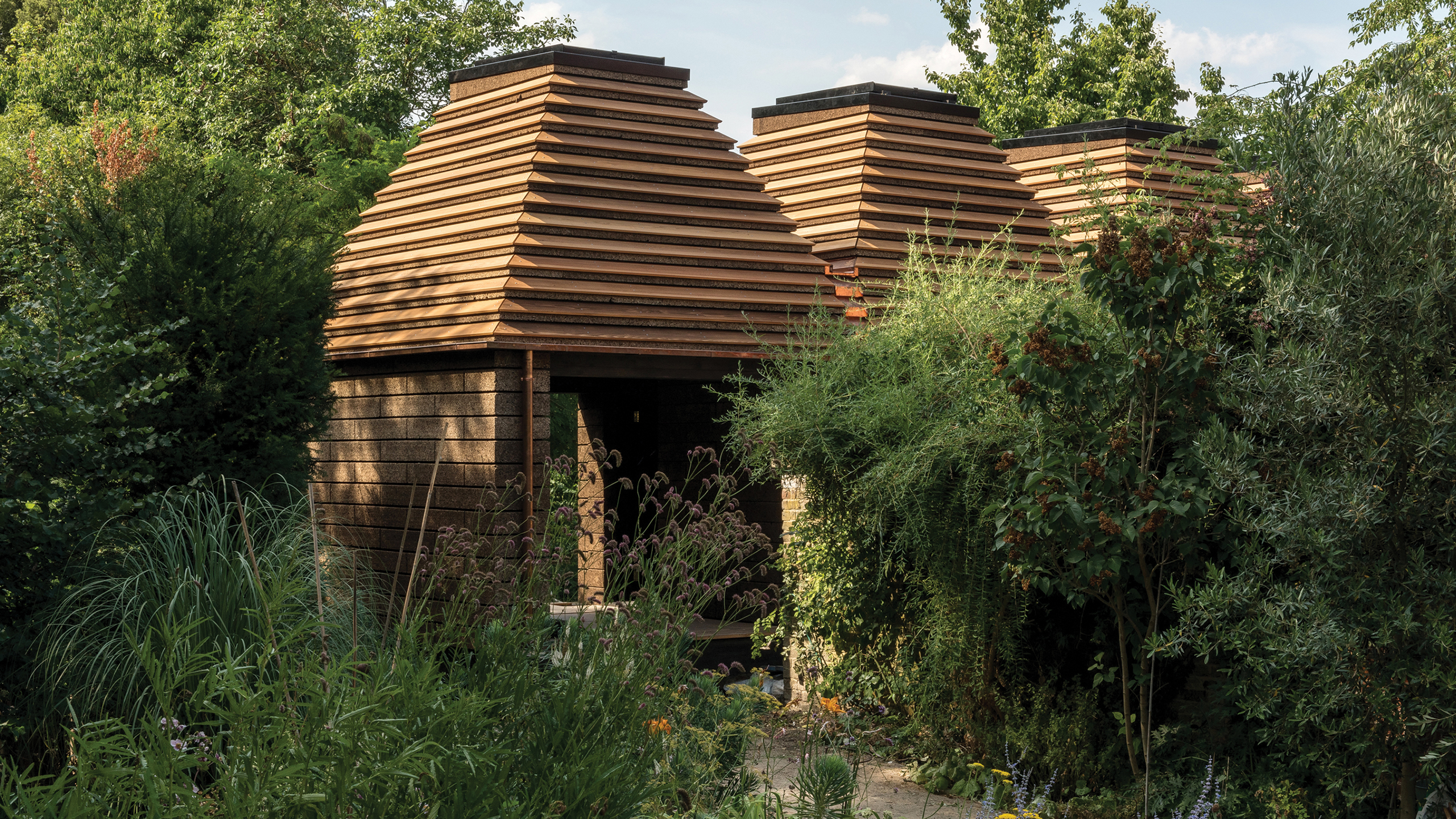
Architect: Waugh Thistleton Architects
Client: American Hardwood Export Council
Structural engineer: Arup
Main contractor: Stage One
CLT panel manufacturer: Construction Scotland Innovation Centre (CSIC)
Lighting design: SEAM
Wood fabricator: Glenalmond Timber Company
Wood species: American tulipwood
Timber donated by: Allegheny Lumber, Bingaman Lumber, Boss Lumber, Classic American Hardwoods, Collins Hardwood, North West Hardwoods, Northland Forest Products, Lathams Timber, Parton Lumber and Thompson Hardwoods.
MultiPly is a carbon neutral engineered timber pavilion, made from hardwood CLT. The vertical maze of stacked modules and staircases creates labyrinthine spaces which intertwine, inviting people to explore the use of wood in architecture and reflect on how we build our homes and cities. MultiPly demonstrates how engineered timber structures can be reconfigured, reused, repurposed and ultimately recycled. The pavilion has been shown in three locations, each iteration taking a different form. The unassuming assembly of modules belies the engineering challenges created by the thinness of panels, significant cantilevers, and the complexity of designing a structure that can be reduced to a set of parts. MultiPly provided an opportunity to push the boundaries of CLT construction. Like a piece of flat-packed furniture, it arrives as a kit of parts and can be quietly assembled in under a week.
COMMERCIAL & LEISURE
The Commercial & Leisure winner: Royal Opera House 'Open Up'.

Location: London
Architect: Stanton Williams
Client: Royal Opera House
Structural engineers: Arup, Robert Bird Group
Main contractor: Swift Crafted Ltd
Joinery: Birmingham Veneers Ltd, TT Gillard, Thornell Veneers Ltd
Construction manager: Rise
Wood supplier: Missouri Walnut LLC
Veneer supplier: Reliance Veneer Co Ltd
Wood species: American walnut
The transformation of the Royal Opera House reimagines the world-renowned home of ballet and opera and strikes the right balance between heritage and 21st century life. Improved access and transparency, a completely new Linbury Theatre and new foyers, terraces, cafes, bars, restaurant and retail facilities extend the building’s life outside of performance hours. At entrance level, subtle timber elements inlaid in the stone floor offer a warm welcome. Descending into the double-height Linbury Theatre foyer, the atmosphere becomes more intimate and theatrical as exquisitely book matched veneer surfaces are complemented by elegant linear grids of timber batons and solid wood parquet. The Linbury Theatre is entirely clad in black walnut, inspired by the rich cherry cladding in the main 1858 Opera House auditorium. Lights, acoustic insulation and sound equipment are integrated within the timber. The judges admired how the new design reads as a complete building, yet seamlessly connects with the main spaces of the existing building.
BESPOKE
The Furniture & Product judges selected two winners within the Bespoke category.
David Gates’s Littoral Chances 1&2 received an award for its singular vision and how it highlights just how much a material can be adapted to the individual’s style.
Designer/maker: David Gates
Vitreous enamel on steel panels: Helen Carnac
Wood supplier: Adamson & Low, English Woodland Timber and Timberline
Wood species: European oak, bog oak, ripple sycamore, Cedar of Lebanon and Douglas fir, American hard maple
This unmatched pair of collecting cabinets is based on the beauty of chance composition. Gates is drawn to industrial and agricultural architecture, including jetties and pylons, and the paraphernalia that populates these sites, such as containers and crates. Gates is often struck by the balance and beauty of chance compositions; how stacked and piled objects present themselves sculpturally. The timber has been sawn, scraped, planed and cleft to emphasise the woods' varying surfaces. The cabinets appear chaotic and improvised but are carefully made using adaptations of traditional construction techniques. The hand-shaped elliptical section of the legs echoes that of yacht masts, further extending the link to the estuary landscape.
PRODUCTION
Ian McChesney Bench is this year’s Production winner.

Designer: Ian McChesney
Manufacturer: Benchmark
Wood supplier: PB Hardwoods and English Woodlands Timber
Wood species: European oak or American Black Walnut
These highly crafted benches are made in two sizes. The gallery bench is designed to sit in the middle of a room and is 900mm deep to allow for sitting on both sides. The foyer bench is designed to sit at the edge of the room and is 600mm deep to allow for sitting on one side only. The gently pillowed top and bottom give the benches a very natural feel. They are carved initially on a 5 axis CNC machine and then assembled and finished by hand to create the elegant edge profile. They are finished with hand applied natural hard wax oils to keep the timber looking and feeling as natural as possible.
GOLD AWARD & PRIVATE WINNER
The judges selected Cork House as this year’s Gold Award and Private category winner. The Gold Award is given to the winner of winners. Judge Ruth Slavid comments, “This is a really exciting project. Not just a house, it is also a piece of research.”

Location: Eton
Architect: Matthew Barnett Howland with Dido Milne and Oliver Wilton
Client: Matthew Barnett Howland and Dido Milne
Structural engineer: Arup
Main contractor: Matthew Barnett Howland with M&P London Contractors Ltd
Joinery: Whyte & Wood
CNC machining of cork blocks: Wup Doodle
Internal joinery: Nic Rhode Furniture
Furniture: Tom Graham Workshop
Wood supplier: NFP Europe Ltd
Wood species: Portuguese cork oak, New Zealand pine, Estonian spruce, American/Canadian western red cedar, Austrian spruce and American white oak
Cork House is built almost entirely from cork and timber. Monolithic walls and corbelled roof pyramids are built with load-bearing expanded cork made from the bark of the cork oak tree, a by-product from wine stoppers. Conceived as a prefabricated kit-of-parts, blocks of expanded cork were CNC-machined off-site and then assembled on-site by hand without mortar or glue. All 1,268 pure cork blocks will be available at end-of-building-life as either biological or technical nutrients. A CLT floor platform, finished with oak floor boards, rests on Accoya beams supported on steel screw piles. Accoya is also used for the bespoke doors, windows and external steps. Western red cedar weatherboarding is used on the roof and rear façade. All internal built-in joinery and loose furniture is made from spruce. Internally, the exposed cork and timber create a rich, evocative, sensory environment.
ABOUT THE WOOD AWARDS
The Wood Awards is the UK’s premier competition for excellence in architecture and product design in wood. The competition began in 1971 as the Carpenters’ Award and was rebranded in 2003 as the Wood Awards. The Awards’ elite independent judging panel of professional experts and specialists not only judges the submitted entries but visits the shortlisted projects in person, making the Wood Awards as meaningful and rigorous a competition as possible. As a not-for-profit competition, the Wood Awards can only happen with collaborative industry sponsorship.
The building’s judging panel is led by three-time Gold Award winner Stephen Corbett of Green Oak Carpentry. The panel includes Andrew Lawrence, Arup; Adam Richards, Adam Richards Architects; Kirsten Haggart, Waugh Thistleton Architects; Nathan Wheatley, engenuiti; David Morley, David Morley Architects; Jim Greaves, Hopkins; Jonas Lencer, dRMM; and architectural journalist Ruth Slavid.
The furniture and product panel is led by design critic, curator and journalist Corinne Julius. The panel includes Oliver Stratford, editor of Disegno magazine; Rod Wales of Wales & Wales; and previous winners Yael Mer of Raw-Edges, Eleanor Lakelin and Sebastian Cox.
Website: www.woodawards.com
Social Media: @WoodAwards
AHEC
AHEC is the leading international trade association for the American hardwood industry, representing the committed exporters among hardwood companies, who now market and sell their products in significant volumes all around the world. For more than 30 years, AHEC has been at the forefront of international wood promotion, successfully building a distinctive and creative brand for American hardwoods. By recognizing the key role design plays in the successful and innovative use of hardwoods AHEC helps the American hardwood industry develop new opportunities by building a rapport with the global design community. In Europe AHEC is renowned for its imaginative and ambitious collaborations with architects and designers to highlight the potential and inspire more use of these sustainable materials.